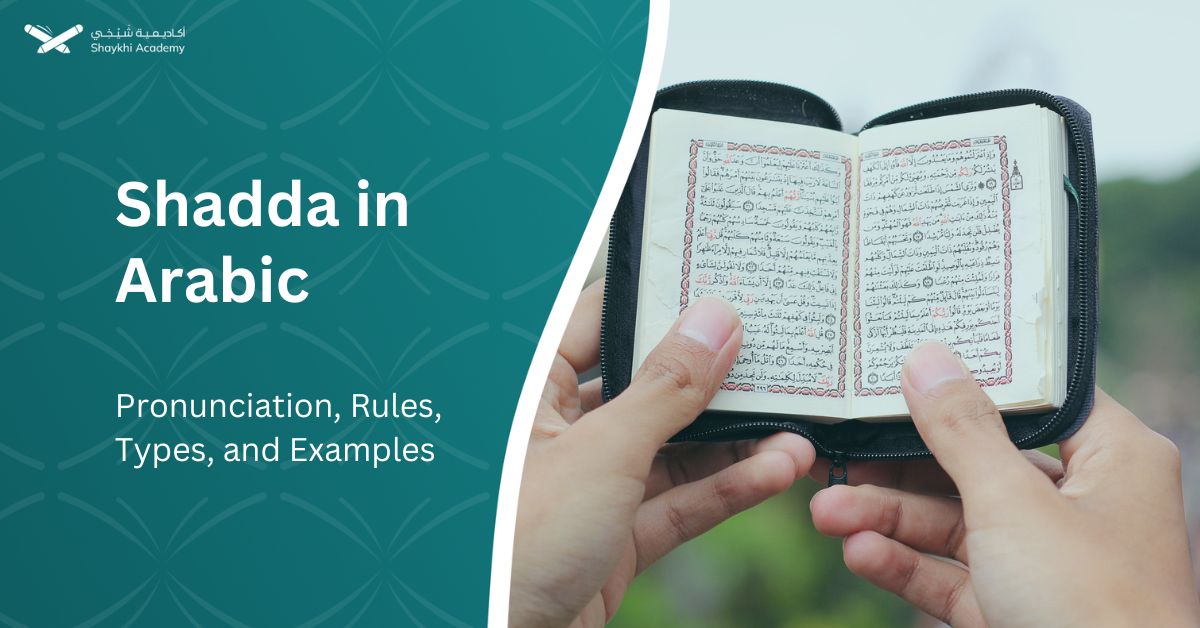Shadda (ـّ) is a key Arabic diacritic that doubles consonant sounds, altering word meanings and enriching expression. From its pronunciation rules to types like Tashdeed Al-Fath, Al-Kasr, and Al-Dam, mastering Shadda ensures clarity and precision in Arabic.
In this blog post, we will explore the meaning, pronunciation, rules, types, and examples of Shadda in Arabic. Shadda is a fascinating Arabic diacritic that adds depth and emphasis to words. Its presence can completely change the meaning of a word and elevate it to a higher level of expression.
Whether you are learning Arabic or simply intrigued by its intricate script, understanding Shadda is crucial. Get ready to uncover the mysteries behind this powerful symbol!
Shadda in Arabic:
The Shadda in Arabic is a small “w” shaped diacritic mark represented by the symbol (ـّ) and placed above a letter. Its main purpose is to indicate the doubling or gemination of a consonant sound within a word. This emphasis is achieved by holding the doubled consonant for a slightly longer duration compared to a regular consonant.
The Shadda plays a crucial role in Arabic orthography as it helps differentiate between words that may share similar spellings but have different meanings, allowing the written script to accurately represent the unique phonetic characteristics of the Arabic language.
Tashdeed In Arabic:
Tashdeed (تشديد), represented by the symbol ّ (Shadda), is a diacritical mark in Arabic used to indicate that a consonant is doubled or pronounced with greater emphasis. It signifies that the letter is pronounced as if it occurs twice, with a brief pause or emphasis.
For example:
- كَتَّبَ (katta-ba) → The letter ت is doubled. The first ت has Sukoon, and the second ت carries Fatha.
- مُسَمَّى (musamma) → The letter م is doubled. The first م has Sukoon, and the second م carries Fatha.
Pronunciation of Shadda in Arabic
The Shadda pronunciation in Arabic involves doubling the consonant sound for clarity and distinction. To indicate this doubling, the same letter is written twice, with the first occurrence marked by a Sakoon (no vowel) and the second occurrence accompanied by a short vowel mark such as Fatha, Dhamma, or Kasra.
This emphasis on the doubled consonant sound is visually represented by placing the Shadda diacritic above the letter. For example, in the word “مَكْكَة,” the Shadda indicates the doubling of the “ك” sound, resulting in the pronunciation “مَكَّة.” By employing the Shadda, Arabic speakers can ensure precise articulation when a consonant is repeated within a word.
Looking to learn Arabic from the comfort of your home? Join our online Arabic course at Shaykhi Academy and unlock the beauty and depth of the Arabic language under the guidance of experienced instructors.
Rules of Shadda in Arabic
Shadda is a significant diacritic in Arabic that indicates the doubling of a consonant sound. It is essential to understand the rules of Shadda to accurately pronounce and write in Arabic. The following are the key rules of Shadda, explained as follows:
1. Doubling Consonants:
Shadda is utilized when two identical consonant letters appear consecutively in a word. The first consonant with Shadda is written with Sukoon (no vowel).
While the second consonant is accompanied by a short vowel. These two consonants are then merged, and a Shadda is placed above the letter to signify its doubled pronunciation.
2. Word Initial Restrictions:
It is important to note that words cannot commence with a letter marked with Shadda. Consequently, the presence of Shadda is strictly limited to non-initial positions within words.
3. Placement with Vowel Marks:
When Shadda is combined with either Fattah or Dammah, it is written above the letter bearing the Shadda.
However, when Shadda is combined with Kasrah, the Kasrah is written below the letter, while the Shadda remains positioned above it.
4. Special Pronunciation:
The letters ن (Noon) and م (Meem) produce a distinct nasal sound, known as Ghunnah when accompanied by Shadda.
Ghunna is solely produced from the nose and is phonetically similar to the sound “hmm.” The duration of the Ghunna sound is approximately two counts.
By following these rules diligently while studying Points of Articulation of The Arabic Letters and practicing regularly using examples from native speakers’ works will help learners gain confidence in their ability to use shadda effectively.
Types of Shadda in Arabic
In the Arabic language, there are different types of Shadda, known as Tashdeed, which are used to emphasize the doubling of a consonant with specific short vowel sounds. These include Tashdeed Al-Fath, Tashdeed Al-Kasr, and Tashdeed Al-Dam.
1. Tashdeed Al-Fath:
Tashdeed Al-Fath is a diacritic mark used in the Arabic language to emphasize the doubling of a consonant with a short vowel sound of “Fatha” (-َ). This is achieved by writing the letter with Shadda (ـَّ) above it. For instance, the word “درَّسَ” (darassa) demonstrates the use of Tashdeed Al-Fath.
In this example, the letter “Ra” (ر) is written with a Shadda (ـَّ) above it, indicating that the “Ra” sound is doubled in pronunciation. The short vowel sound of “Fatha” (-َ) is added to the second “Ra”. This emphasizes the doubling of the “Ra” sound in the word “درَّسَ”.
2. Tashdeed Al-Kasr:
Tashdeed Al-Kasr is another diacritic mark used in Arabic to emphasize the doubling of a consonant with a short vowel sound of “Kasra” (-ِ). It is represented by writing the letter with Shadda (ـِّ) above it. An example of this is the word “طَيِّبٌ” (tayyibun).
In this example, the letter “Yaa” (ي) is written with a Shadda (ـِّ) above it, indicating that the “Yaa” sound is doubled in pronunciation. The short vowel sound of “Kasra” (-ِ) is added to the second “Yaa”. This highlights the doubling of the “Yaa” sound in the word “طَيِّبٌ”.
3. Tashdeed Al-Dam:
Tashdeed Al-Dam is a diacritic mark used in Arabic to emphasize the doubling of a consonant with a short vowel sound of “Damma” (-ُ). It is denoted by writing the letter with Shadda (ـُّ) above it. An example illustrating this is the word “وَلِيٌّ” (waliyun).
In this example, the letter “Yaa” (ي) is written with a Shadda (ـُّ) above it, signifying that the “Yaa” sound is doubled in pronunciation. The short vowel sound of “Damma” (-ُ) is added to the second “Yaa”. This draws attention to the doubling of the “Yaa” sound in the word “وَلِيٌّ”.
These examples showcase the utilization of Shadda to indicate the doubling of a consonant with different short vowel sounds. It is worth noting that the pronunciation and usage of Shadda may vary depending on the specific word and context within the Arabic language.
Examples of Shadda in Arabic
In Arabic, the diacritical mark Shadda (ـّ) is used to signify the doubling of a consonant within a word. We will now provide a detailed explanation for each example that demonstrates the use of Shadda in Arabic.
Example 1:
The word “شَدَّةٌ” (shadda) itself serves as an example of Shadda usage. In this case, the consonant “dal” (د) is doubled, and this duplication is indicated by the presence of Shadda (ـَّ) above the “dal” character.
Example 2:
In the word “جَنَّةٌ” (jannatun), Shadda (ـَّ) replaces one occurrence of the consonant “noon” (ن). This replacement with Shadda signifies the doubling of the “noon” sound during pronunciation.
Example 3:
The word “طَرِيٌّ” (tariyyun) contains a doubled “Yaa” (ي) consonant. The repetition of the “Yaa” sound is emphasized by the existence of Shadda (ـُّ) above the character.
Example 4:
With Tashdeed Al-Kasr, the word “عَنِّيْ” (‘anni) exemplifies the use of Shadda (ـِّ) to represent the doubled “Noon” (ن) sound. In this case, the Shadda indicates the repeated pronunciation of the “Noon” sound.
Example 5:
The word “فَنَّانٌ” (fannanun) showcases Tashdeed Al-Fath where Shadda (ـَّ) denotes the duplication of the “noon” (ن) sound. This example highlights the use of Shadda to indicate the doubling of consonant sounds.
These examples showcase how shadda enhances pronunciation and distinguishes between similar-sounding words. Understanding these variations helps learners gain proficiency in reading and speaking Arabic accurately.
Learn Fusha Arabic from Experts: Enroll in Shaykhi Academy’s Comprehensive Language Program!
At Shaykhi Academy, we offer Fusha Arabic classes that are designed to help students develop a strong foundation in the Arabic language. Our expert instructors utilize a comprehensive curriculum that covers all aspects of Fusha Arabic.
In addition to the classes, we also provide access to the renowned Al-Menhaj book, which is widely recognized as an authoritative resource for learning Arabic.
Whether you are a beginner or looking to further improve your Arabic proficiency, our Fusha Arabic classes at Shaykhi Academy, along with the Al-Menhaj book, will guide you toward achieving your language goals.

Conclusion
Shadda is an important diacritic mark in the Arabic language that signifies the doubling of a consonant sound. It plays a crucial role in determining pronunciation and word meaning. Shadda designs vary in their appearance but always serve to emphasize the letter it is placed on.
Understanding the different types of shadda, such as Tashdeed Al-Fath, Tashdeed Al-Kasr, and Tashdeed Al-Dam, allows for accurate pronunciation and proper interpretation of words. By following the rules of shadda usage, learners can enhance their understanding and mastery of Arabic script.
If you are interested in learning more about Fusha Arabic or want to delve deeper into topics like shadda, consider enrolling in Fusha Arabic classes at Shaykhi Academy and referring to resources like the Al-Menhaj book for comprehensive study materials.

















































